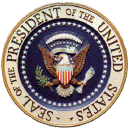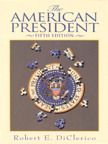
American Presidency
Political Science 347, section 01
Fall 2000

| Professor: Dr. Dave Rausch, Ph.D.
Office: 404C Old Main Phone: 651-2423 Email: jrausch@mail.wtamu.edu Webpage: http://wtfaculty.wtamu.edu/~jrausch Office hours: M-F 11:00 a.m. - 12:00 noon; other times by appointment |
Table of Contents
Course Description
Course Goals
Texts
Recommended
Reading
Semester
Project
The
Topics
Exams and Grading
Class Participation
Attendance Policy
Academic Dishonesty
Student ADA Policy Statement
Your Responsibilities
Course Outline and Schedule
Return to American Presidency Page
Course Description
This course examines the primary relationships and responsibilities
of the American presidency. By studying the president's relationships
and responsibilities we will gain a greater understanding of the opportunities
and limitations for presidential leadership in the contemporary political
system. In addition, we will better understand why presidents and
those associated with presidents act the way they do and why these actions
have the consequences they have.
Course Goals
This course has four goals:
 |
DiClerico and Davis. 2000. Choosing Our Choices; Debating the Presidential Nominating Process. Lanham, MD: Rowman & Littlefield Publishers, Inc. |
 |
DiClerico. 2000. The American President, 5th ed. Upper Saddle River, NJ: Prentice Hall. |
 |
Scott and Garrison. 2000. The Political Science Student Writer's Manual, 3rd ed. Upper Saddle River, NJ: Prentice Hall (Optional, but highly recommended). |
Additional readings will be distributed in class or made available on reserve in Cornette Library.
Recommended Reading
I recommend that you follow the activities of the current president
(a lame duck) in the news media. You also should follow the campaign
of the men who would like to be the next President. Although, as
we will discuss, the media may not be the optimal filter through which
to view the activities of the president, it is far easier than gaining
access to the President yourself. The library subscribes to the Washington
Post. The Post is available on the web. Another interesting
source of news about the presidency is Congressional Quarterly Weekly
Report, which also is available in the library. Several news
sources have websites; particularly useful is the one for the Associated
Press. There are numerous sites on the Web that report on the
activities of President Clinton, and the candidates for president.
Semester Project
You have the opportunity to choose from five options for your semester
project. The finished paper should be from 8 to 12 pages (typed,
double-spaced) in length. The paper will be due on Thursday, November
30.
The paper must be well-written, ideas and quotes borrowed from other authors must be cited and the paper must include a list of sources (failure to comply with these requirements will be construed as plagiarism and will be rewarded with a failing grade - for the course! - no excuses).
All papers must contain some proper form of citation - students should obtain an appropriate style manual, one which applies to social science. I recommend the styles discussed in The Political Science Student Writer's Manual.
Generally speaking, any of the following three forms is acceptable: footnotes, endnotes, or parenthetical citations. For the last of these the most appropriate form is: (Rausch 1999). If there is a page number involved - only when you are making a direct quote - it should be about like this: (Rausch 993, 23). For two authors: (Copeland and Rausch 1993). For multiple authors: (Rausch, et al. 1993). Get the picture? For the other forms it is not necessary to use all the Latin terms you may have used or seen (op cit, supra, ibid.). A simple reference to the author's name is fine (with any accompanying date and page info for an author whose name appears more than once).
Additionally, this is a 300-level class. As such, it is inappropriate to use only one or two sources, the encyclopedia, or just the assigned course readings. Students should make an effort to link their research to the materials they have read for class.
There will be NO EXTENSIONS without a written medical excuse from a bonafide phy-sician - YOUR PROCRASTINATION IS NOT MY PROBLEM! Further, please comply with the following guidelines:
You will want to start your project early enough to allow for any possible inter-library loan activities.
If you need help in clarifying the requirements or the topics please do not hesitate to ask.
Exams and Grading
Your primary responsibility is keeping up with the reading. Only
by doing so will you gain from class discussion. I will freely call
on students to contribute thoughts about the reading. The reading
assignments are listed below. You will be graded on (1) a mid-term
exam, (2) a final exam, and (3) the semester project. The final exam
will cover only the last half of the course. The exams will consist
of "short answer," or identification questions, and essay questions.
Points will be distributed as follows:
| Mid-term exam | 100 points |
| Final exam | 100 points |
| Semester project | 100 points |
The mid-term exam is scheduled for Tuesday, October 10. The final exam is sched-uled for Thursday, December 7, at 8:00 a.m. The final exam will be similar in format to the mid-term.
I will provide study terms and concepts well before the exams (in fact, I probably will dis-tribute these as we work through each topic). These guides should assist you in orga-nizing your thoughts and notes.
The last day to drop or withdraw with an automatic "X" grade is October 13, 2000.
Class Participation
I expect some discussion in this class: someone raises an issue
presented in the text and we discuss the issue. Certainly with the
campaign and the eventual transition, we should have some "current events"
to relate to what we are reading about.
Attendance Policy
I do not take attendance at the beginning of each class. I do,
however, note who is here, who habitually comes in late, and who leaves
early. Please be aware that you are responsible for any material
discussed during missed class sessions. If you miss an exam, you
must arrange to make it up.
Academic Dishonesty
I enforce the policies on Academic Dishonesty listed in the student
handbook.
Student ADA Policy Statement
West Texas A&M University seeks to provide reasonable accommodations
for all qualified persons with disabilities. This University will
adhere to all applicable federal, state and local laws, regulations and
guidelines with respect to providing reasonable accom-modations as required
to afford equal educational opportunity. It is the studentís responsibility
to register with Disabled Student Services and to contact the faculty
member in a timely fashion to arrange for suitable accommodations.
Your Responsibilities
To get the most out of this course, treat it as a job (standard college
advice). Be here on time for every class. READ THE TEXTBOOKS.
Ask questions of material you do not understand. If you have difficulty
reading or writing, tell me (outside of class if you wish) and I will help
you find the appropriate resources to improve those skills.
Course Outline and Schedule
[This schedule is subject to change; you will be notified of changes]
August 29:
Introduction to Course Objectives and Procedures
August 31:
Library Assignment
September 5-7:
The Presidency: Creation and Development
Read:
DiClerico, Preface, pp.
xi-xv
Handouts
September 12-21
Presidential Selection Process
Read:
DiClerico, Chapter 1
DiClerico and Davis, All
Handouts
I will identify the readings for each day. You will find Chapter 1 of DiClerico summarizes the arguments in DiClerico and Davis (go figure!). The second half of DiClerico and Davis are documents.September 26-28
October 3-5
First Branch v. Second Branch
Read:
DiClerico, Chapter 3
October 10
Mid-term exam
Please bring blue books
October 12-17
Presidential Approval and Press Relations
Read:
DiClerico, Chapter 4
October 19-24
President as Chief Executive I: Working with the
Bureaucracy
Read:
DiClerico, Chapter 5
October 26-31
President as Chief Executive II: Making Decisions
Read:
DiClerico, Chapter 6
November 2
Case Studies in Presidential Decision Making
Read:
DiClerico, Chapter 7
November 7-9
Emergency Powers
Read:
DiClerico, Chapter 8
November 14-16
Barber's Presidential Personality
Read:
DiClerico, Chapter 9
November 21
Rating the President
Read:
Handouts and Webpages
November 28-30
Leadership
Read:
DiClerico, Chapter 10
December 5
The Veep
Read:
DiClerico, Chapter 11
Thursday, December 7, at 8:00 a.m.
Final Exam
Please bring blue books